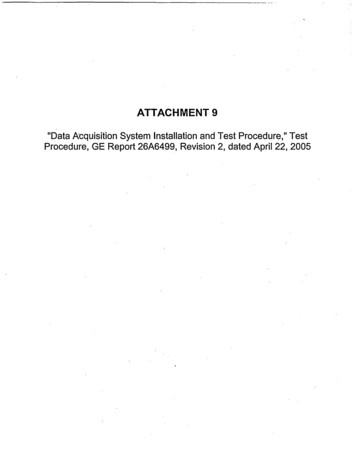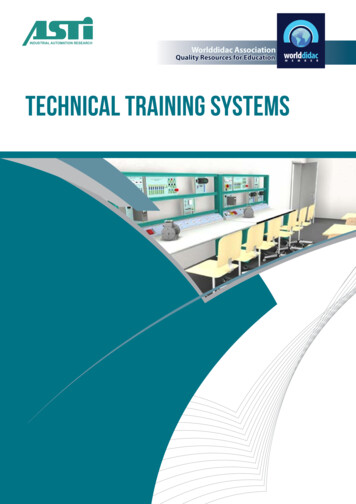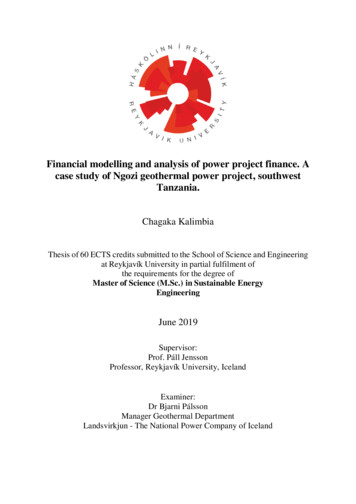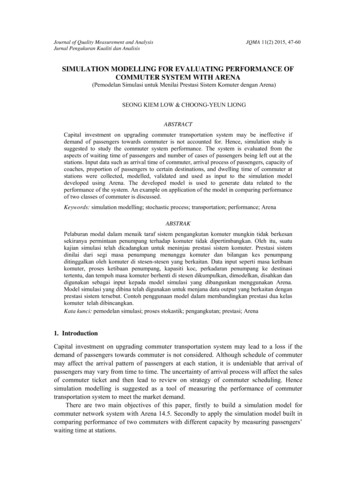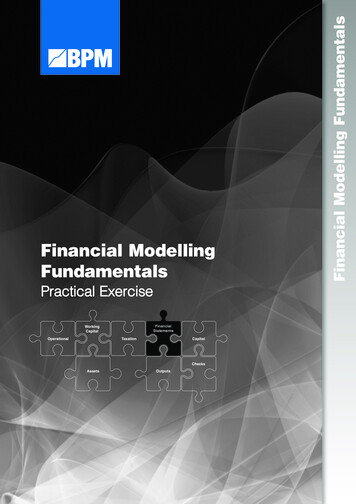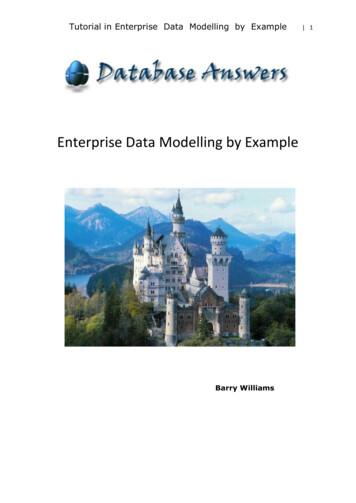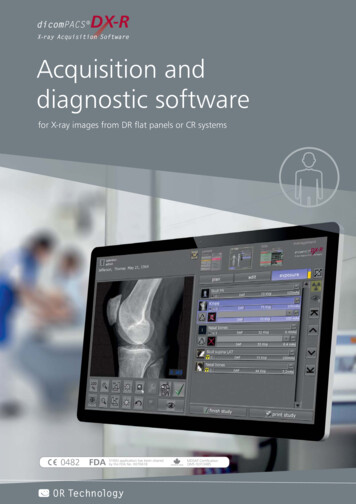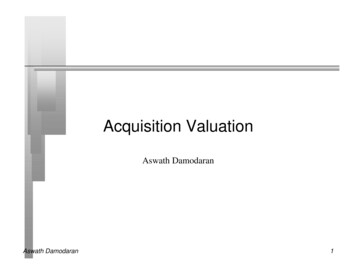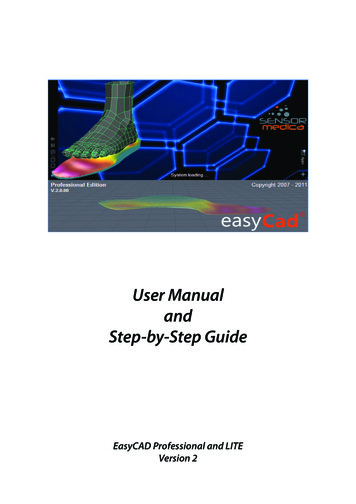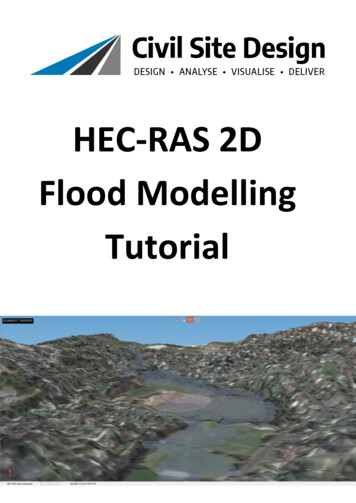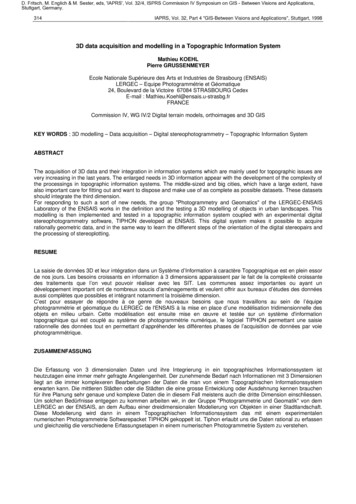
Transcription
D. Fritsch, M. Englich & M. Sester, eds, 'IAPRS', Vol. 32/4, ISPRS Commission IV Symposium on GIS - Between Visions and Applications,Stuttgart, Germany.314IAPRS, Vol. 32, Part 4 "GIS-Between Visions and Applications", Stuttgart, 19983D data acquisition and modelling in a Topographic Information SystemMathieu KOEHLPierre GRUSSENMEYEREcole Nationale Supérieure des Arts et Industries de Strasbourg (ENSAIS)LERGEC – Equipe Photogrammétrie et Géomatique24, Boulevard de la Victoire 67084 STRASBOURG CedexE-mail : Mathieu.Koehl@ensais.u-strasbg.frFRANCECommission IV, WG IV/2 Digital terrain models, orthoimages and 3D GISKEY WORDS : 3D modelling – Data acquisition – Digital stereophotogrammetry – Topographic Information SystemABSTRACTThe acquisition of 3D data and their integration in information systems which are mainly used for topographic issues arevery increasing in the last years. The enlarged needs in 3D information appear with the development of the complexity ofthe processings in topographic information systems. The middle-sized and big cities, which have a large extent, havealso important care for fitting out and want to dispose and make use of as complete as possible datasets. These datasetsshould integrate the third dimension.For responding to such a sort of new needs, the group "Photogrammetry and Geomatics" of the LERGEC-ENSAISLaboratory of the ENSAIS works in the definition and the testing a 3D modelling of objects in urban landscapes. Thismodelling is then implemented and tested in a topographic information system coupled with an experimental digitalstereophotogrammetry software, TIPHON developed at ENSAIS. This digital system makes it possible to acquirerationally geometric data, and in the same way to learn the different steps of the orientation of the digital stereopairs andthe processing of stereoplotting.RESUMELa saisie de données 3D et leur intégration dans un Système d’Information à caractère Topographique est en plein essorde nos jours. Les besoins croissants en information à 3 dimensions apparaissent par le fait de la complexité croissantedes traitements que l’on veut pouvoir réaliser avec les SIT. Les communes assez importantes ou ayant undéveloppement important ont de nombreux soucis d’aménagements et veulent offrir aux bureaux d’études des donnéesaussi complètes que possibles et intégrant notamment la troisième dimension.C’est pour essayer de répondre à ce genre de nouveaux besoins que nous travaillons au sein de l’équipephotogrammétrie et géomatique du LERGEC de l'ENSAIS à la mise en place d’une modélisation tridimensionnelle desobjets en milieu urbain. Cette modélisation est ensuite mise en œuvre et testée sur un système d'informationtopographique qui est couplé au système de photogrammétrie numérique, le logiciel TIPHON permettant une saisierationnelle des données tout en permettant d’appréhender les différentes phases de l’acquisition de données par voiephotogrammétrique.ZUSAMMENFASSUNGDie Erfassung von 3 dimensionalen Daten und ihre Integrierung in ein topographisches Informationssystem istheutzutagen eine immer mehr gefragte Angelengenheit. Der zunehmende Bedarf nach Informationen mit 3 Dimensionenliegt an die immer komplexeren Bearbeitungen der Daten die man von einem Topographischen Informationssystemerwarten kann. Die mittleren Städten oder die Städten die eine grosse Entwicklung oder Ausdehnung kennen brauchenfür ihre Planung sehr genaue und komplexe Daten die in diesem Fall meistens auch die dritte Dimension einschliessen.Um solchen Bedürfnisse entgegen zu kommen arbeiten wir, in der Gruppe "Photogrammetrie und Geomatik" von demLERGEC an der ENSAIS, an dem Aufbau einer dreidimensionalen Modelierung von Objekten in einer Stadtlandschaft.Diese Modelierung wird dann in einem Topographischen Informationssystem das mit einem experimentalennumerischen Photogrammetrie Softwarepacket TIPHON gekoppelt ist. Tiphon erlaubt uns die Daten rational zu erfassenund gleichzeitig die verschiedene Erfassungsetapen in einem numerischen Photogrammetrie System zu verstehen.
D. Fritsch, M. Englich & M. Sester, eds, 'IAPRS', Vol. 32/4, ISPRS Commission IV Symposium on GIS - Between Visions and Applications,Stuttgart, Germany.Koehl & Grussenmeyer11.1315INTRODUCTIONPreliminary considerationsCAD tools in association with the tools of digitalphotogrammetry are currently very efficient and offer thepossibilities to acquire, to reconstruct and to representvery complex and detailed 3-D objects. But the movingfrom a 2-D system to 3-D system is not a very simplecase. In fact, in 3-D there are a lot of parts and faceswhich are not visible from any point of the operators orusers view. In this case it is necessary to dispose in a full3D system of tools for efficient 3D drawing and of toolsthat makes it possible to compute element by usingextrapolation algorithms.The operator who wants to acquire 3D data has to see theobjects in 3D, has to represent them in 3D onto a 2Dscreen and has to be aware of the depth onto digitalimages. These different problems are solved by usingCAD software which can represent complete 3D objects.In this case, the using of algorithms to eliminate hiddenlines for example allows to distinguish and to be aware ofthe 3 dimensions of the objects. But these tools are whollyfunctioning only in the case of the objects drawn with strictspecifications like the using of only solids or faces.The meaning of these first considerations is that therepresentation of 3D objects needs a big work ofstructuration and reconstruction.To reach this goal of having complete reconstructed andCAD compatible objects, the operator has to be supportedin the different steps of 3D data acquisition.- An example of this support can be the superimposition ofthe CAD drawing onto the digital images.- A second way to support the operator during the dataacquisition is to propose him the definition of a library ofgeneric objects that are, for example, deduced from thegeometry of the building rooftops.- A last help to the operator can be the implicitstructuration of these different generic objects, so thatthey are compatible with the system as soon as they areacquired.1.22THREE DIMENSIONAL MODELLINGThe 3D modelling deals in the same time with geometricmodelling, topologic and thematic modelling of objects.2.1The geometric modellingThe geometric modelling is based on a dominanthierarchical structure of complex objects which arecomposed and made (aggregation) of basic geometricelements.The 3-D objects, which are in our case mostly buildingcomponents or road infrastructures (bridges) areincorporated in a surface model composed of a DigitalTerrain Model (DTM). This DTM is the ground surfaceonto which all the complex 3-D objects are projected.Some 3-D objects like buildings are completed under theDTM with an inferior ground surface that simulates thevault (Figure 1).The 3D objects in urban landscapesLike in the aerial photographs used in photogrammetry, a3D object in an urban landscape, even in a not very densebuilt city, has often hidden parts that can not be directlyacquired. But in many cases the objects (for example thebuildings) are composed of elements that could be easilyrebuilt by using of extrapolation tools like horizontal orvertical projections, like orthogonality or parallelityconstraints.The tools of photogrammetry coupled with a CAD engineare in this case very interesting to be used. In fact, theyallow in a first step to acquire interactively and in a easyway the "visible" parts of the objects, and then to achievethe reconstruction by using the 3D CAD tools and theextrapolation tools.1.3The Microstation environment is running onto the most ofthe computers plateforms and is very efficient by using aPC with Windows 95 or NT. Like other CAD engine,Microstation can be coupled to external applications whichcan be used to the digitizing of the data points.At the ENSAIS, in the "Photogrammetry and Geomatics"group we develop since 1996 a software application fordigital stereophotogrammetry : TIPHON (Traitementd'Image et PHOtogrammétrie Numérique).This software application allows to realize measurementsinto digital images. This application will be described in anext section. It was at first developped in the goal ofteaching digital photogrammetry at ENSAIS.In our project we can use TIPHON to acquire thecaracteristic visible endpoints of our 3D objects in ascanned pair of digital images. In this way we can developand test our system in a very simple PC environment.WorkstationIn our project, we choose to work with the well knownCAD software package Microstation from Bentley which isvery well working in 3D and offers a large frame of 3Dtools.Figure 1 : DTM and a 3D object projected on itThe geometric modelling is realized by the using of alibrary of 3-D objects which is mostly composed withmodels of rooftops.A building object is, for instance, an extrapolation (verticalprojection on the DTM) of the rooves limits (Figure 2).A bridge is constructed with a surface (runway) that has athickness, and with pilars which are projected on theground DTM.
D. Fritsch, M. Englich & M. Sester, eds, 'IAPRS', Vol. 32/4, ISPRS Commission IV Symposium on GIS - Between Visions and Applications,Stuttgart, Germany.316IAPRS, Vol. 32, Part 4 "GIS-Between Visions and Applications", Stuttgart, 19983/ Association of thematic attributes by using oflinks with a database.Here we can only find automation by using of acodification or a classification of the elements which arebased on the CAD attributes of the drawn elements.2.32.3.1Figure 2 : Common models of rooves2.2The data acquisitionThe data acquisition is done in two ways :In the first case, the objects are completely defined ingraphic cells and are arranged in a library of objects.The operator has here to select the complex objectwith its geometry and the different associatedthemes. Afterwards, he has to pick up the geometryin the images of the real world. A second stepconsists to decompose the cells automatically intoelementary objects and elements of objects. This firstmodus is used in the case of classical shapes. Theacquisition of data is here very efficient but needs along step for initial conception and modelling. Thismodelling will revolve with new classical objects or ifthe operator wants to enlarge his library of objects.This acquisition is performed in the following steps :1/ Creation of the object library. Each object hasan implicit topology.2/ Linking of the objects and components ofobjects with thematic attribute tables in adatabase.3/ Acquisition of the complex objects in the wayof the constraint determination.4*/ Decomposition of the object into singleelements.5*/ Creation of the topologic relations.6*/ Association between the object componentsand their thematic definitions.(the steps followed by a * are made automatically)--In the second case, the objects are not completelycomplexed, their aggregation is not totally predefined,and they are not stored in an initial object library. Theoperator has here to compose step for step theobjects and the differents themes that are associatedto them. He can occasionally supplement the libraryof objects but this will need another long step ofmodelling. This second method is used in the case ofnon common and not repeating objects.For the acquisition of a particular, unique and specificobject, there exists also the common way ofacquisition which is used in classical G.I.Ss. Thestructure of the object is given them by following thesteps described below :1/ Acquisition of the geometry.2/ Transformation of the geometric CADelements into object features.The geometric data acquisition supported bythe using of objects described by a genericshape.Predefined ordered shapesA first form allows to acquire these generic shapes byfollowing a predefined order of points.This is a fast method, but needs a great apprenticeship ofthe acquisition methods for the operator and needs,above all, the possibility to acquire all the points definedduring the conception of the generic shape (Figure 3).The operator has to insert the primitive in the groundcoordinate system, to orient it and to redimension it bymeasuring its parameters.This method is an efficient data acquisition method fornone accurate but regular and basic objects.All the generic shapes which are acquired in this way existin two versions : in a first version, the shape isconstructed with the minimum number of points, withoutany redundancy and no adjustment is available ; in asecond version, the structural lines can be constructedand adjusted by using redundant measures.Figure 3a – 3b : Predefined ordered shapes2.3.2Constraint cellsA second way allows to acquire objects in form ofconstrainted or dimension-driven cells. The cells arepredefined in topologic terms of nodes, arcs, loops andfaces. This approach allows to be independent from theorder of acquisition of the object points or the parametersof the primitive (Figure 4).
D. Fritsch, M. Englich & M. Sester, eds, 'IAPRS', Vol. 32/4, ISPRS Commission IV Symposium on GIS - Between Visions and Applications,Stuttgart, Germany.Koehl & Grussenmeyer2.3.33173Codified primitivesA last method uses generic shapes which are codified andin which the operator has to identify the significantendpoints or keypoints that he will measure on the realobject. Each primitive includes characteristic elementsand construction rules. This method of acquisition needs agreat interactivity between the system and the operator.The acquisition of the data is interactively made by theidentification of a constitutive element on a model of thecodified primitive (Figure 5).The interactivity could be very unefficient if it is used allthe time. In another way, it allows to acquire objectswithout following the order that was predefined in thegeneric shape, and above all, it allows also to acquire theobject even if not all predefined points are visible ormensurable.The thematic modelling is implemented and tested byusing a relational database. The generic shapes (complexobjects) are structured as aggregations of objects andelements of objects which have themselves a thematicsignification attached. At the time of acquisition, theoperator has the possibility to redefine the thematicstructuration of each object, but this will prejudice theautomation of the acquisition.The modelling is applied to a testfield which is a part ofthe city of Metz (France) where we can find the most ofthe specific objects that constitute an urban environment.(see below the testfield).The thematic structuration is defined into categories (setof objects with a predominant thematic). The differentkinds of objects are classified in such a predominantthematic class, but this means not that the objects can notshare different thematics or that the object componentscan not be connected to different thematics.A strict hierarchic structuration of the themes would behere an important limitation of the managementpossibilities which are offered by such a system.The objects which are classified into different categoriesenclose an own internal thematic structure which is alsopredominantly hierarchic. This internal structure is definedby the user at the creation of the different generic forms orstep by step at the creation of a non previously registeredform. An object instance can in this way contain objectelement from all, a part or none of the different hierarchicthematic levels. (Figure 6)44.1Figure 4a – 4b : Constraint cellThe two last approaches could be very efficient in mostcases, particularly if the primitive can not be captured inone time because of failing of visibility in the stereopair forexample.THE TOPOLOGIC MODELLINGThe definition ofdimensionthetopology anditsThe topologic modelling is only realized for objects with areal third dimension. In reference to the followingdescribed testfield (see paragraph 6.2), the topolgicmodelling concernes in the general case only the objectsof the categories 1 to 4 and 7 and 8The topology of the elements of the first 4 categories(Relief, Hydrology, Roads, Vegetation) is a classicaltopology which has mainly 2 dimensions.The topology of the element from the categories 7(Buildings) and 8 (Constructions) has 3 dimensions.The specific elements of the topology are nodes, arcs,faces and loops for the first categories and are completedwith the bodies which concerne the second categories.4.2Figure 5 : Codified primitiveTHE THEMATIC MODELLINGTopologic decompositionIn some cases, the topology is known in an implicit waybecause of the decomposition of generic complex objectsas defined above. In this case, the creation and therecording of the topology is automatically performed.There exists a second way of topologic decompositionwhich works locally. Each 3-D complex object isautomatically codified and topologicaly decomposed intonodes, arcs, loops and faces. This way of decompositionis running only in a local area but can take in accountlocal adjacencies.
D. Fritsch, M. Englich & M. Sester, eds, 'IAPRS', Vol. 32/4, ISPRS Commission IV Symposium on GIS - Between Visions and Applications,Stuttgart, Germany.318IAPRS, Vol. 32, Part 4 "GIS-Between Visions and Applications", Stuttgart, 1998Figure 6 : Thematic structureThis topologic decomposition offers the possibility tocreate a file containing the topologic structure of a 3-Dcomplex object which allows to manage the vicinity.At this time the topology is a redundant information. Infact, all the topologic informations are treated in a specificdatabase which contains redundant information incomparison to the different design files.5SOFTWARE APPLICATION FOR THEGEOMETRIC DATA ACQUISITIONThe data acquisition is realized by using an experimental,PC and Windows based system for digitalstereophotogrammetry : "TIPHON" (Traitement d’Image etPHOtogrammétrie Numérique) developped at ENSAIS.This system is used for the practical work of terrestrial andaerial stereophotogrammetry with all kinds of cameras.In this study about 3D modelling, the objects aremeasured on aerial photographs at the scale of 1/2500.The TIPHON software allows the different steps of theorientation of a digital stereopair. The measurement onthe images are manual or semiautomatic by correlation.The stereoplotting of points, lines and polylines is directlysuperimposed on the images on the screen.TIPHON is interconnected to the CAD-GIS softwarepackage Microstation/Geographics from Bentley wherethe modelling and the structuration are implemented.Figure 7 : TIPHON software for digital photogrammetry
D. Fritsch, M. Englich & M. Sester, eds, 'IAPRS', Vol. 32/4, ISPRS Commission IV Symposium on GIS - Between Visions and Applications,Stuttgart, Germany.Koehl & Grussenmeyer66.1319TEST FIELDTest fieldTo realize the tests of the different steps of the modellingand the data acquisition we use a test field from the city ofMetz in France. For this area we have got a set of aerialphotographs in the scale of 1/2500. These images have arelativ great scale. This allows us to acquire differentslevels of details in the photographs. It allows us also tosee very precisely what kind of problem we will encounterwhen we acquire 3-D datasets.The test field has great height differences and enclosesdense built areas, middle dense built areas and not buildareas. It offers also great roads infrastructures.In this test field, the 2-D elements were acquired by usingan analytical stereoplotter ZEISS P33. These elementswere directly structured into different levels.The 3-D elements were digitized by using the TIPHONsoftware and the different geometric, topologic andthematic tools described in this work.7CONCLUSIONThe integration of 3D instances of complex objects into asystem allows to think about other new applications thatare not available in 2D systems. But the complexityprovided to the 3D system by this supplementarydimension is so large that we need to define newstructures for the data. A great problem when we work in3-D is the acquisition of data and their structuration.To perfom this very efficiently we need a lot of new toolsfor data acquisition, data structuring and datarepresentation (Figure 8).A software package TIPHON, for digital photogrammetryallows to acquire data in vector mode. A CAD engine likeMicrostation makes it possible to complete thereconstruction of the 3-D objects.New tools for data structuring, topology decompositionand thematic description by using a database areimplemented.8REFERENCESReferences from Journals :Rongxing, L. ; 1994 ; Data structures and applicationissues in 3-D geographic information systems ;Geomatica vol. 48, N 3, pp. 209 to 224.Grussenmeyer P., Morot C., Goujon Y. ; 1998; "TIPHON"un logiciel de photogrammétrie numérique développé àl’ENSAIS. Revue de l’Association Française deTopographie, XYZ n 75, 2/1998, pages 61-66.References from Books :Figure 7 : DTM built from Relief, Hydrology and Roads6.2ModellingFor the thematic structuration of the project we have built9 Categories :1/ Relief (*)2/ Hydrology (*)3/ Roads (*)4/ Vegetation (**)5/ Signals (**)6/ Urban furniture (**)7/ Buildings (***)8/ Constructions (***)9/ Setting (****)(*)The elements of the first 3 categories are used to buildthe D.T.M.(**)The elements of the categories 4 to 6 makes it possibleto ornament the 3-D visualizations by using 3D point andline objects but which have no real interests in 3-Dmodelling.(***)The categories 7 and 8 contain the principal reasonsof this work because they contain mainly 3-D complexobjects.(****)The last categorie offers the possibility of therepresentation and the geolocalisation into the workspace.Bill, R. ; Fritsch, D. ; 1991 ; Grundlagen derGeoInformationssysteme, Band 1 Hardware, Softwareund Daten ; Karlsruhe, Wichmann.Kraus,K. ;1994 ;VerfeinerteMethodenundTopographische Informationssysteme, PhotogrammetrieBand 2. ; Dümmler Verlag, Bonn.Kraus, K. ;1996 ; Verfeinerte Methoden undAnwendungen, Photogrammetrie Band 2. (3. Auflage) ;Dümmler Verlag, Bonn.Rouet, P. ; 1992 ; Les données dans les systèmesd’information géographique ; Editions Hermes, Paris.References from other Literature :Bric V. ; Pilouk M. ; Tempfli K. ; 1994 ; Towards 3D-GIS :Experimenting with a vector data structure ;Athens, USA ; ISPRS, Vol. XXX, Part 4.Carosio, A. ; 1995 ; Three-Dimensional SyntheticLandscapes : Data Acquisition, Modelling andVisualization ; Photogrammetric Week’95, Wichmann.Dietrich, A. ; 1995 ; 3D-GIS der Altstadt Regensburg ;Photogrammetric Week’95, Wichmann.Kager, H. ; Halmer, A. ; Heitzinger, D. ; 1996 ; Modellingof 3D-Surfaces with Basic Topological Structures ;Vienna, Presented paper Commission IV, IAPRS Vol.XXXI/4.
D. Fritsch, M. Englich & M. Sester, eds, 'IAPRS', Vol. 32/4, ISPRS Commission IV Symposium on GIS - Between Visions and Applications,Stuttgart, Germany.320IAPRS, Vol. 32, Part 4 "GIS-Between Visions and Applications", Stuttgart, 1998Koehl, M. ; 1996 ; The modelling of urban landscapes ;Vienna, Presented paper Commission IV, IAPRS Vol.XXXI/4.Koehl, M. ; 1997 ; Topologic Models for geometricreconstructions, Presented paper Commission IV,IAPRS Vol. 32, Stuttgart.Kraus, K. ; 1991 ; Die dritte Dimension in GeoInformationssysteme ;Schriftenr. des Institutes für Photogrammetrie derUniversität Stuttgart, Heft 15 pp. 167-176.Morakot, P. ; 1996 ; Integrated Modelling for 3D GIS ;PhD Dissertation, ITC, The Netherlands.Morot, C., Grussenmeyer, P., 1996. Development ofPC-based digital photogrammetric software at theENSAIS Department of Surveying : the TIPHONsoftware. Proceedings of the GIS Euroconference,Madrid, sept. 18-20, 1996, 6 p.Figure 8: Part of testfield and DTMNeureither, M. ; 1992 ; Modellierung geometrischtopologischer Daten zur Beschreibung und Berechnungnetzartiger und Fläschenhafter Strukturen ;Dissertation, DGK, Heft nr 387.Pfeiffer, N. ; Pottmann, H. ; 1996 ; Surfaces Models onthe Basis of Triangular Mesh-Surface Reconstruction ;Vienna, Presented Paper Commission III, IAPRS Vol.XXXI/3.Tempfli, K. ; Pilouk, M. ; 1996 ; Practicablephotogrammetry for 3D-GIS ;Vienna, IAPRS Vol. XXXI, part B4, pp. 859-867.
Microstation can be coupled to external applications which can be used to the digitizing of the data points. At the ENSAIS, in the "Photogrammetry and Geomatics" group we develop since 1996 a software application for digital stereophotogrammetry :


